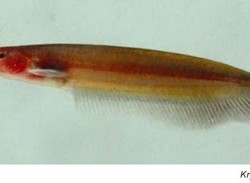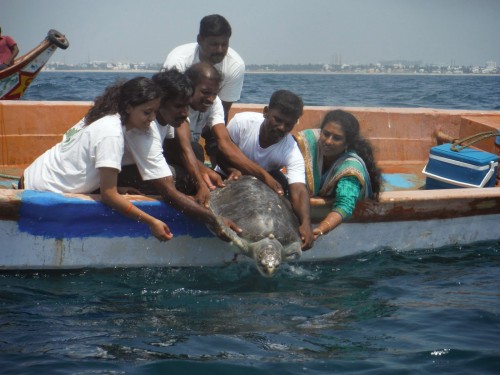Nature is full of suprises and we get to re-establish this fact everyday when new discoveries bringforth ever new challenges into the world that we human falsely believe we know a lot about. The latest puzzle by mother nature thrown to us humans is a tiny Catfish Kryptoglanis shajii, hardly the size of a little finger and with a bull-dog like snout. Desptie studying it since 2011 when it was discovered in India, the scientific community is still baffled with regard to its classification because the fish is so unique.
Kryptoglanis shajii is a small, subterranean catfish with a number of defining skeletal features, including a bulging lower jaw similar to that of a bulldog. The fish is an elusive species that is seen deep underwater and rarely visible to the human eye. Native to only one region in the world, the Western Ghats mountain range in Kerala, it emerges occasionally in the springs, wells and flooded rice paddies of the region.
The subterranean catfish was categorized as a new species only in 2011. John Lundberg, emeritus curator of ichthyology at the Academy of Natural Sciences of Drexel University in Philadelphia, while studying the species began to take a closer look at the specimens of the new breed of fish.
And the closer he looked, the deeper the mystery became!
“The more we looked at the skeleton, the stranger it got,” Lundberg, said in a statement. “The characteristics of this animal are just so different that we have a hard time fitting it into the family tree of catfishes.”
One Like no Other
From the outside, this particular catfish looks similar to other catfishes, but a closer look inside the fish yields some surprising discoveries, Lundberg said. Using digital radiography and high-definition CAT scans to study the bone structure of the fish his team found that the species was missing several bony elements.
Although the missing parts is not very shocking because other subterranean fishes, have been observed to lack some of the bones found in other fishes. What made the classification difficult was that the shapes of some of Kryptoglanis’ bones were also totally unique found in no other known fish species.
Several individual bones in the face of the catfish’s were modified, giving it a compressed front end with a protruding lower jaw thereby giving it an appearance like a bulldog’s snout. The little fish also has four rows of conical, sharp-tipped teeth, the researchers said.
According to Lundberg, this modified appearance in primarily one part of the body of the fish could be a functional adaptation
“In dogs, that was the result of selective breeding,” Lundberg said. “In Kryptoglanis, we don’t know yet what in their natural evolution would have led to this modified shape.”
The probability of this modification being due to this new fish species’ diet has been ruled out by the researchers. This is because, in the natural underground habitat that the species is found, its diet comprises of small invertebrates and insect larvae. Videos have proved that the 4 inch long fish does and is capable of eating such food.
Different Studies, Same Result
Interestingly, in another part of the globe, using other techniques while studying the same species, researchers have come to similar conclusions. But the catfish continues to remain a mystery.
Ralf Britz, a fish researcher at the Natural History Museum of London, conducted a separate study of the unique bone structure of the species.
While Lundberg’s study used the latest in technology (high-resolution X-ray computed tomography) and created three-dimensional CAT scan images of the fish’s skeleton, Britz and his team used a very old technique usually used in anatomy and biology known as “clearing and staining”. In this method of visualizing a skeleton, a dead animal is treated with a series of chemicals that simultaneously preserve it, render its soft tissues transparent, and stain its skeletal and nervous systems different colors.
Inspite of the interest of many scientists globally to understand the morphology and anotomy of this unusual fish, there are still a lot of questions that remain unasnwered. Neither of the two studies were able to decisively conclude why Kryptoglanis is so unique among fishes, or what species may be counted as its closest relatives.
Lundberg’s study is published in the 2014 issue of the Proceedings of the Academy of Natural Sciences of Philadelphia and the research of Ralf Britz was published in the March 2014 issue of the journal of Ichthyological Exploration of Freshwaters.
More Related Stories,
New Species of Catfish Discovered
Critically Endangered Gharial Tagged in Hope of Saving Species
14 Species of Unusual Dancing Frogs Discovered in Western Ghats






